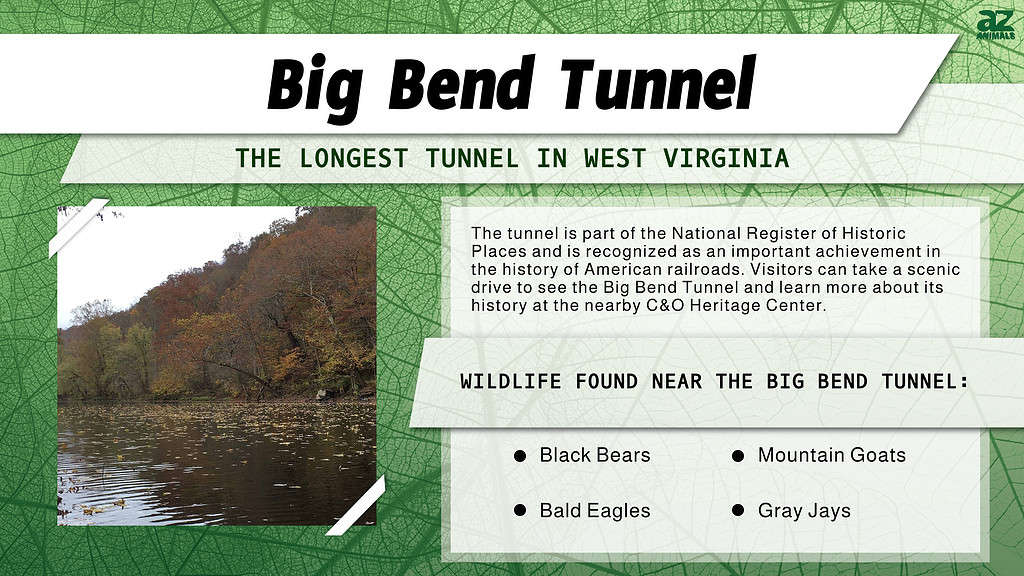West Virginia is known for having many tunnels, both natural and man-made, due to its mountainous terrain. In this article, we will discover the longest tunnel in West Virginia. Are you ready to explore this modern miracle? Let’s go!
What Is The Longest Tunnel in West Virginia?
The longest tunnel in West Virginia is the Big Bend Tunnel, which is located on the Chesapeake and Ohio Railway (C&O) in Summers County. The tunnel is 6,450 feet long and was completed in 1873. It was designed and built by the famous engineer Collis P. Huntington. The tunnel was an important part of the C&O Railway, which connected the industrial city of Huntington in West Virginia with the eastern seaboard.
History Of The Big Bend Tunnel: A Modern Miracle
The tunnel is located in West Virginia and is an impressive feat of engineering that has stood for over a century now!
The Big Bend Tunnel was built as part of the Chesapeake & Ohio Railway (C&O). This railway ran from Richmond, Virginia all the way down to Cincinnati, Ohio. During its construction, it had one major obstacle – getting through Big Bend Mountain, separating two separate valleys on either side.
To get around this problem engineers decided to build a 2-mile-long tunnel through it instead! Construction began with over 1000 workers employed by C&O working hard day and night until finally, they completed their task – finishing ahead of schedule too!
The Big Bend Tunnel in West Virginia was built using traditional tunnel construction methods for that era, including hand drills, dynamite, and pickaxes. Workers carved the tunnel out of the solid rock of the mountain using these tools, and they lined the interior of the tunnel with brick and stonework.
The construction of the Big Bend Tunnel was difficult and dangerous. The workers used hand drills and gunpowder to blast through the hard rock. The work was often done in dark, damp conditions. The workers were mainly Irish and African American, who were often paid less than white workers and had to work under harsh conditions.
Regardless, they completed this impressive project– something that’s quite remarkable given how dangerous such work can be today even with modern safety measures taken into account.

Did Anyone Die While Building The Big Bend Tunnel In West Virginia?
There were several deaths that occurred during the construction of the Big Bend Tunnel in West Virginia. According to historical records, the working conditions in the tunnel were hazardous, and many workers were killed in accidents such as tunnel collapses and explosions. The exact number of deaths during the construction of the tunnel is not known, but it is estimated to be in the dozens or possibly even hundreds.
Is The Big Bend Tunnel Closed?
The Big Bend Tunnel in West Virginia is still currently in use as part of the CSX Transportation railroad network and is not closed. However, the original tunnel built in 1872 was closed in 1932 and replaced with a new parallel tunnel. The new tunnel remains in use today and is an important part of the railroad network in the region.
Today you can still travel through this historic tunnel if you take C&O’s scenic route from Richmond up towards Cairo Junction where trains pass right under big bend mountain each day – just like they have been doing since 1928!
What’s It Look Like Inside The Big Bend Tunnel In West Virginia?
The interior of the Big Bend Tunnel in West Virginia is an active railway tunnel, and it is not safe or legal for the public to enter without proper authorization and safety equipment/gear. However, historically, the tunnel was constructed using brick and stone masonry and was lined with wooden beams to support the roof. The tunnel is approximately 6,800 feet long, and it curves around Big Bend Mountain. During the construction of the tunnel, workers used hand drills and explosives to carve out the rock and create the passage.
Can You Visit The Big Bend Tunnel?
Today, the tunnel is part of the National Register of Historic Places and is recognized as an important achievement in the history of American railroads. Visitors can take a scenic drive to see the Big Bend Tunnel and learn more about its history at the nearby C&O Heritage Center. The center features exhibits, artifacts, and interpretive displays that tell the story of the region’s railroad history.
Where Is the Big Bend Tunnel Located on a Map?
Big Bend Tunnel is located near Talcott, approximately 10 miles east of Hinton, West Virginia, 153 miles southeast of Huntington, and 100 miles southeast of Charleston, West Virginia. Richmond, Virginia is almost 240 miles due east of the tunnel.
The photo featured at the top of this post is © LesPalenik/Shutterstock.com
Thank you for reading! Have some feedback for us? Contact the AZ Animals editorial team.







